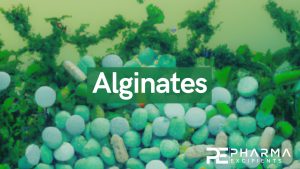Alginate-Based Electrospun Nanofibers and the Enabled Drug Controlled Release Profiles: A Review
![Figure 4. (A) TEM image of embedded nanosilver PCL fibers. (scale = 100 nm) [20]. (B) SEM images of 0.2% (w/v) collagen grafted nanofiber [74]. (C) TEM image of HNT-LEV/SA-PEO nanocomposite fibers at an electron acceleration voltage of 100 kV (scale = 300 nm) [65]. (D) Schematic diagram of the research-designed electrospinning process (two-column diagram) [65].](https://www.pharmaexcipients.com/wp-content/uploads/2024/07/Alginate-electrospun-fibers-for-biomedical-applications-and-for-drug-delivery-and-controlled-release-modalities.jpg)
Abstract
Alginate is a natural polymer with good biocompatible properties and is a potential polymeric material for the sustainable development and replacement of petroleum derivatives. However, the non-spinnability of pure alginate solutions has hindered the expansion of alginate applications. With the continuous development of electrospinning technology, synthetic polymers, such as PEO and PVA, are used as co-spinning agents to increase the spinnability of alginate. Moreover, the coaxial, parallel Janus, tertiary and other diverse and novel electrospun fiber structures prepared by multi-fluid electrospinning have found a new breakthrough for the problem of poor spinning of natural polymers. Meanwhile, the diverse electrospun fiber structures effectively achieve multiple release modes of drugs. The powerful combination of alginate and electrostatic spinning is widely used in many biomedical fields, such as tissue engineering, regenerative engineering, bioscaffolds, and drug delivery, and the research fever continues to climb. This is particularly true for the controlled delivery aspect of drugs. This review provides a brief overview of alginate, introduces new advances in electrostatic spinning, and highlights the research progress of alginate-based electrospun nanofibers in achieving various controlled release modes, such as pulsed release, sustained release, biphasic release, responsive release, and targeted release.
Introduction
Sodium alginate (SA) is a natural polymer extracted from marine algae that has a wide range of applications in the industrial field because of its unique and excellent structural and chemical properties, including the preparation of new materials for pharmaceutical preparations, the biomedical field, the food field, the cosmetic field, and the environment field [1,2,3,4,5,6]. Natural reserves of SA are very abundant, and natural polymers are preferred over synthetic polymers due to their excellent biocompatibility and natural degradability, and they are considered sustainable and promising alternatives to petroleum-derived polymers [7,8].
With the development of nanotechnology, the preparation of nanostructured SA materials has gained in-depth research and made great progress [9]. Nowadays, multiple techniques are available to prepare alginate-based nanomaterials with different sizes, morphologies, and compositions, such as electrostatic spinning [10], electrostatic spraying [11], controlled gelation [12], 3D bioprinting [13], cast film [14], self-assembly [15], phase separation [16], microfluidic technology [17], and other technologies. Electrostatic spinning technology is a cutting-edge, convenient, cost-effective, and commonly used preparation method for preparing nanofibers. In the past decades, researchers have deeply explored the biomedical applications of electrospun alginate-based nanofibers in tissue engineering, regenerative engineering, bioscaffolds, and drug and gene delivery [3,10,18,19,20].
In order to achieve and maximize the desired therapeutic effect, the drug needs to be embedded in a suitable delivery system so as to achieve specific release characteristics [21]. Among them, electrospun nanofibers are considered one of the most promising nanotechnologies for overcoming the current challenges and shortcomings of modern drug delivery systems and achieving the desired release pattern [22,23,24]. Sodium alginate nanofiber (SANF) membranes prepared based on electrostatic spinning technology have excellent properties, such as high specific surface area, high drug loading capacity, controlled drug delivery, and reduced drug side effects [21]. In addition, the nanomaterials transformed by electrospun alginate nanofibers (EANFs) possess unique properties, such as the balance between degradation rate and swelling index, which greatly facilitates the development of new-generation scaffolds, drug delivery systems, and regenerative biomaterials [25].
However, the poor spinnability of natural polymers is a non-negligible problem [26,27]. Synthetic polymers are superior to natural polymers in terms of processability, mechanical properties, loading properties, and reusability. On the other hand, synthetic polymers are cost effective as carriers. However, synthetic polymers are inert, do not adequately interact with surrounding cells in most cases [3], and are not easily degraded [28]. The combination of natural and synthetic polymers for the development of electrospun delivery drug systems is an ingenious strategy to address the issues of functionality, biocompatibility, and material–tissue integration [3]. Meanwhile, nanofibers with different structures prepared by single-fluid, two-fluid, and multi-fluid electrospinning can improve the spinnability of spinning dysfunctional polymers to some extent [26,29,30].
The literature on “electrospinning & alginate” and “electrospinning & alginate & drug delivery” was searched on the “Web of Science” platform from 2004 to 2024. As shown in Figure 1, the amount of literature on the topic of “electrospinning & alginate” has been increasing year by year, indicating that the preparation of SANFs by electrospinning has become a research hotspot. Although the number of papers with the theme of “electrospinning & alginate & drug delivery” is small, it is also on the rise, indicating that the development prospect of electrospun nanofibers in the field of drug delivery is also very bright.
![Figure 4. (A) TEM image of embedded nanosilver PCL fibers. (scale = 100 nm) [20]. (B) SEM images of 0.2% (w/v) collagen grafted nanofiber [74]. (C) TEM image of HNT-LEV/SA-PEO nanocomposite fibers at an electron acceleration voltage of 100 kV (scale = 300 nm) [65]. (D) Schematic diagram of the research-designed electrospinning process (two-column diagram) [65].](https://www.pharmaexcipients.com/wp-content/uploads/2024/07/Figure-4.-A-TEM-image-of-embedded-nanosilver-PCL-fibers.-scale-100-nm-300x268.jpg)
Download the full article as PDF here : Alginate-Based Electrospun Nanofibers and the Enabled Drug Controlled Release Profiles
or read it here
Zhang, Z.; Liu, H.; Yu, D.-G.; Bligh, S.-W.A. Alginate-Based Electrospun Nanofibers and the Enabled Drug Controlled Release Profiles: A Review. Biomolecules 2024, 14, 789. https://doi.org/10.3390/biom14070789
Read also our introduction article on Alginates here:


